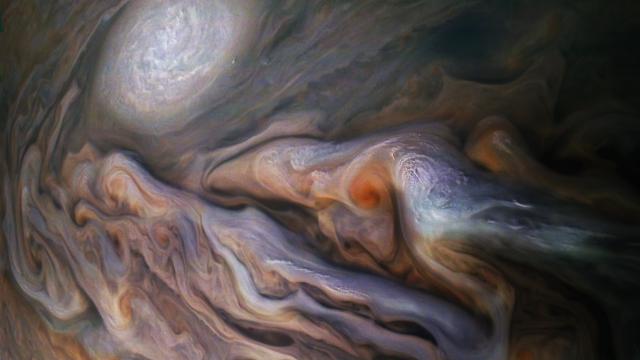The International Astronomical Union has approved new names for five recently discovered moons around Jupiter.
When it comes to moons, Jupiter is an embarrassment of riches. Our solar system’s largest planet boasts a whopping 79 moons, 12 of which were discovered in early 2017. The astronomers who made the discovery, a team led by Scott Sheppard from the Carnegie Institution for Science, launched a public contest earlier this year to name five of the new Jovian moons.
“There are many rules when it comes to how we name moons,” explained Sheppard in a Carnegie Science press release. “Most notably, Jovian naming conventions require its many moons to be named after characters from Greek and Roman mythology who were either descendants or consorts of Zeus, or Jupiter.”
Other restrictions included a maximum of 16 characters per name, and final letters had to correspond to the moon’s direction of orbit (i.e. moons in retrograde orbit must end with an “e” and moons in prograde must end with an “a.”). Proposed names could not include an offensive word in any language or culture, or commemorate living persons, among many other restrictions.
The contest ran from February 21 to April 15. All entries had to be submitted via tweet, which meant participants had to make their case in 280 characters or less. But as the press release pointed out — and to virtually no one’s surprise — many people blatantly disregarded these guidelines. The Carnegie team had to disregard the inevitable and numerous Moony McMoonFace entries, names of favourite pets, and the like.
Eventually, the team settled on five names, which were recently approved by the International Astronomical Union (IAU). The new names are Pandia, Ersa, Eirene, Philophrosyne and Eupheme. The moons range in size from 1 to 3 kilometers (0.6 to 1.9 miles) wide, with Pandia being the largest among them.
Pandia (formerly S/2017 J4) is the “daughter of Zeus and the Moon goddess Selene” and “the goddess of the full moon and the sister of Ersa,” according to the press release. Pandia was among the most popular names entered.
#NameJupitersMoons Pandia!! daughter of Zeus and Selene, goddess of moon’s.
Also our schools logo/mascot is a panda, very similar name. The Astro club chose this name! Our village used to provide London zoo with bamboo for the pandas that lived there. pic.twitter.com/wR0940PHNc— emma hugo (@emmabray182) March 20, 2019
Ersa (formerly S/2018 J1) is the “sister of Pandia and, as such, also the daughter of Zeus and the Moon goddess Selene” and “the goddess of dew,” according to the press release, to which it was added: “Being the daughter of a Moon goddess seemed very appropriate for a Jovian moon.”
Congrats Walter!!!
— Mark D Cleghorn (@MarkCleghorn3) August 23, 2019
Eirene (formerly S/2003 J5) is the goddess of peace and the daughter of Zeus and Themis. Philophrosyne (formerly S/2003 J15) is the spirit of welcome and kindness, the granddaughter of Zeus, and the sister of Eupheme. Eupheme (formerly S/2003 J3) is the spirit of praise and good omen, the granddaughter of Zeus, and the sister of Philophrosyne, according to the Carnegie Science press release.
So, some very nice new monikers — and it’s fortunate so many names exist in the Roman and Greek mythological canon! Otherwise we’d have to seriously consider Moony McMoonFace, which in my opinion wouldn’t be so bad. Weird is good.
